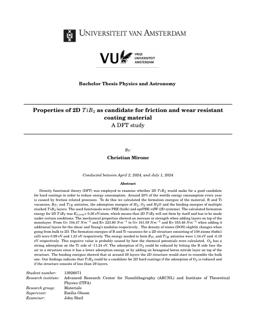2025-05-19
Properties of 2D TiB2 as candidate for friction and wear resistant coating material: A DFT study
Publication
Publication
Density functional theory (DFT) was employed to examine whether 2D TiB2 would make for a good candidate for hard coatings in order to reduce energy consumption. Around 20% of the worlds energy consumption every year is caused by friction related processes. To do this we calculated the formation energies of the material, B and Ti vacancies, B_Ti and Ti_B antisites, the adsorption energies of H2, O2 and H2O and the binding energies of multiple stacked TiB2 layers. The used functionals were PBE (bulk) and optPBE-vdW (2D systems). The calculated formation energy for 2D TiB2 was E_form= 0.26 eV/atom, which means that 2D TiB2 will not form by itself and has to be made under certain conditions. The mechanical properties showed an increase in strength when adding layers on top of the monolayer. From G= 104.47 N m−1 and E= 223.60 N m−1 to G= 161.59 N m−1 and E= 355.46 N m−1 when adding 4 additional layers for the shear and Young’s modulus respectively . The density of states (DOS) slightly changes when going from bulk to 2D. The formation energies of B and Ti vacancies for a 2D structure consisting of 108 atoms (6x6x1 cell) were 0.99 eV and 1.23 eV respectively. The energy needed to form B_Ti and Ti_B antisites were 1.34 eV and -0.19 eV respectively. This negative value is probably caused by how the chemical potentials were calculated. O2 has a strong adsorption on the Ti side of -11.24 eV. The adsorption of O2 could be reduced by letting the B side face the air in a structure since it has a lower adsorption energy, or by adding an hexagonal boron nitride layer on top of the structure. The binding energies showed that at around 29 layers the 2D structure would start to resemble the bulk one. Our findings indicate that TiB2 could be a candidate for 2D hard coatings if the adsorption of O2 is reduced and if the structure consists of less than 29 layers.
| Additional Metadata | |
|---|---|
| E. Olsson (Emilia) | |
| University of Amsterdam, UvA , VU University Amsterdam | |
| Organisation | Materials Theory and Modeling |
|
Mirone, C. (2025, May 19). Properties of 2D TiB2 as candidate for friction and wear resistant coating material: A DFT study. |
|

